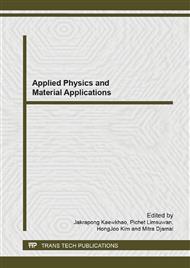p.80
p.84
p.88
p.92
p.96
p.100
p.104
p.108
p.112
Preparation of Ruby Red Glasses from Gold Nanoparticles: Influence of Soaking Time
Abstract:
In this research, effects of soaking time in melting glass process on red color development have been investigated. The red glasses were prepared from gold nanoparticles (AuNPs) with compositions of 70.475SiO2 : 11Na2O : 9CaO : 9K2O : 0.005SeO2 : 0.5SnO2 : 0.02AuNPs % by weight and vary soaking time at 1 to 5 hours. The glasses were melted the normal melt-quench technique. The color of glasses were measured by uv-visible spectrophotometer in the wavelength range 300-900 nm and color coordinate in CIEL*a*b* system. The result found that, the glasses sample with 1 and 2 hours of soaking time are shown purple color. At 3, 4 and 5 hours of soaking time are shown red color. The results reflecting that the particle size of gold particle in glass matrices at 3, 4 and 5 hours are smaller than 1 and 2 hours of soaking time.
Info:
Periodical:
Pages:
96-99
Citation:
Online since:
September 2013
Authors:
Keywords:
Price:
Сopyright:
© 2013 Trans Tech Publications Ltd. All Rights Reserved
Share:
Citation:


